语法总结 :
顺序在最后
" * " 就相当于 一整排的意思
insert into 是写入这行 如果遇到非空 必须赋值 哪怕是 null
alter 是改变的意思 用于结构的增加列 一般和 alter table.... add ...
update 是更新数据的意思 用于给 字段 更改值 update ....set....
想显示两个 就在 select后面 两个字段并且用个 , 隔开 如 : pid,pname
想看一组的数据 就先引用 alter add 加上cid列 再 用update set给列分开 最后 用group by 查这组的值
4.1 数据准备
#
创建商品表
create table product(
pid int primary key auto_increment,
pname varchar(20),
price double,
pdate timestamp
)
#
自动增长列:auto_increment,要求:1,必须整型(int) 2.必须是主键
insert into product values (null,'
谭妮平',0.01,null);
insert into product values (null,'
李士雪',38,null);
insert into product values (null,'
左慈',-998,null);
insert into product values (null,'
黄迎',99999,null);
insert into product values (null,'
南国强',99998,null);
insert into product values (null,'
士兵',1,null);
insert into product values (null,'
李士兵',698,null);
4.2 简单查询(重点前3个)
查询的语法:
s
elect 要查询的字段 from 表名
where
条件;
1.
查询
所有
商品
s
elect
* from
表名
;
select * from product;
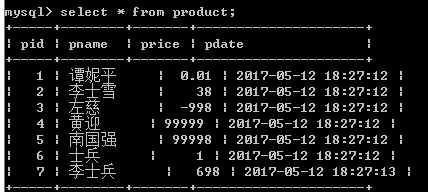
2.
查询商品名和商品价格
s
elect 要查询的字段(多个字段用逗号隔开) from 表名;
select
pname,price
from product;
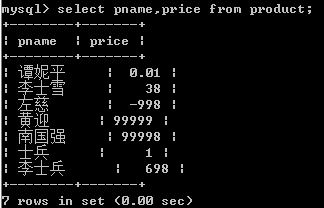
3.
查询所有商品信息使用表别名
【单表没啥卵用,主要用于多表操作!】
s
elect
* from
表名 别名;
select * from product p;
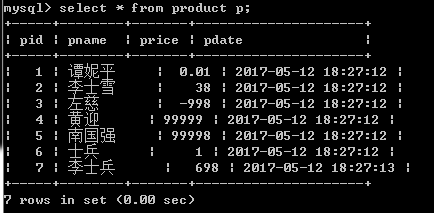
4.
查询商品名,使用列别名(相对表别名使用要少一些。)
select
列名 列别名
from
表名;
4.3 条件查询
-
语法:select * from 表名 where 条件
1.
查询商品名称为"左慈"的商品信息 - --- 查一行
s
elect
* from product where pname=’
左慈
’
;

2.
查询价格>60元的所有商品信息
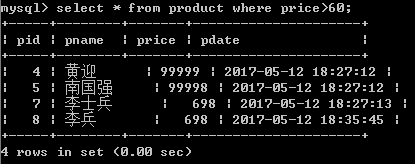
3.
查询商品名称含有"士"字的商品信息【
模糊查询
】
select * from
表名
where
字段名
like ‘%
士%
’
;
【%表示任意个字符】

查询商品名称以"士"字开头的商品信息
select * from
表名
where
字段名
like ‘
士%
’;
【%表示任意个字符】

查询商品名称第二字为"士"字的商品信息
select * from
表名
where
字段名
like ‘_
士%
’;
【_表示1个字符】

4.
查询商品id在(3,6,9)范围内的所有商品信息【关键字
in
】
s
elect
* from product where pid
in(3,6,9);

and or not
5.
查询商品名称为士兵
并且
价格>0的商品信息
说明:并且(
and
)

6.
查询商品名称含有士字
或者
价格>100的商品信息
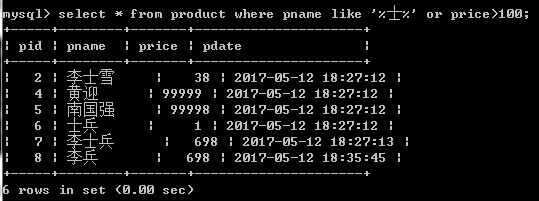
7.查询
id
不是2
的商品信息 -----
not (pid = 2); != 也行
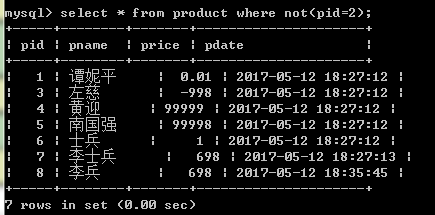
8.
查询价格在100到10000之间的商品信息
between A and B (前后闭区间 都包)

4.4 排序
排序语法:select * from 表名
order by
指定的
字段名称
[
asc
升序]/desc降序
-
查询所有的商品,按价格进行排序(升序、降序)
升序:
select * from product order by price asc;
或者
select * from product order by price;
降序:
select * from product order by price asc;
1.2.
查询名称有"士"的商品信息并且按照价格降序排序
select * from product where pname like '%
士%' order by price desc;
注意:order by排序操作必须放在where 条件的后面!!!
4.5 聚合
之前的查询操作都是横向操作(以行为单位进行查询),使用聚合函数,可以进行纵向操作(以列为单位进行查询,查询的结果是单独的一列) 就和Excel一样

语法:select 函数名称(给定列名) from 表名
2.1.
获得所有商品的价格的总和 sum
s
elect
sum(price) from product;
2.2.
获得所有商品的平均价格 avg
se
lect
avg(price) from product;
2.3.
获得所有商品的个数 count
s
elect
count(
*
) from product;
4.6 分组
语法:select * from 表名
group by
分组的字段名称 这个只在把一组当成一个整体的时候才用,分组是用的加列的思想;
1.
添加分类id (alter table product add cid varchar(32);) --加上cid这个列而已
2.
初始化数据 --- 给这个列赋值
update product set cid='1';
update product set cid='2' where pid in (5,6,7);
查询:
3.1.
根据cid字段分组,分组后统计商品的个数。 --- 统计每组的
select cid,count(cid) from product
group by
cid;
3.2.
根据cid分组,分组统计每组商品的平均价格,并且平均价格大于20000元。
select cid,avg(price) from product
group by
cid having avg(price)>20000;
如果进行了分组操作,还带有条件,不能使用where关键字,必须使用having,而且只能放在最后面!!!

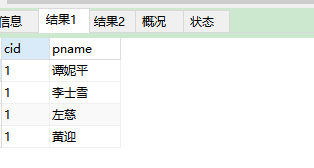
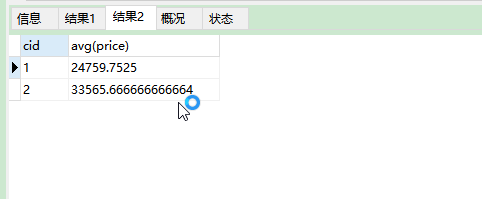
4.7 分页查询
LIMIT


select * from product limit 2; 查前两个
select pname from product limit 4,2;
公式 :
(要看的页码数 - 1)*每页显示大小
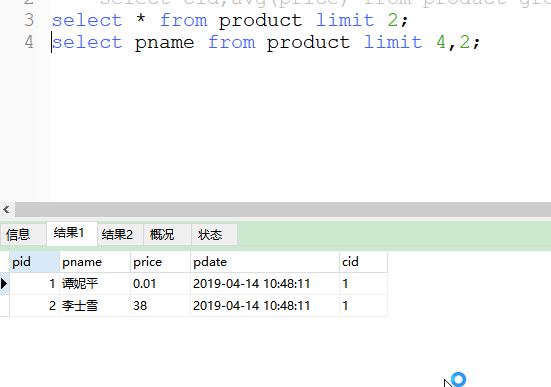
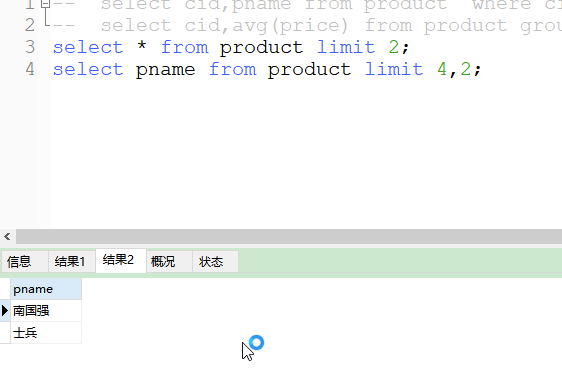
4.9 删除 delete from 表名 全删
delete from 表名 where 条件
delete from product where pid=8;
4.8单表查询总结 顺序
开发中关于查询语句应该怎么去写
?
【关键字出现的顺序如下:】
select
被查询的字段(所有的字段写
*
)【一般都是 的 字后面的内容】
from
表名
where
条件 【一般都是 的 字前面的内容】
grou
p by
分组的字段名称 【一般会明确指定根据什么来分组】
order
by
升序还是降序(
asc/desc
)
【一般会明确指定根据什么来分组】
having 条件(分组后的条件)
【一般会明确指定根据什么来分组】























 865
865

 被折叠的 条评论
为什么被折叠?
被折叠的 条评论
为什么被折叠?








